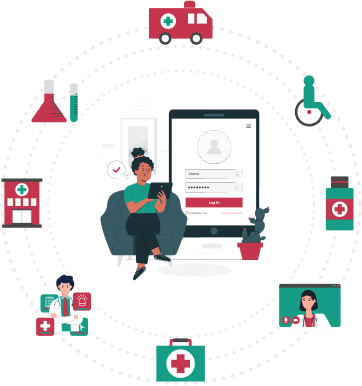Technology has revolutionised different industries, and emergency medical services are no different. Over the years, online ambulance services have gained much popularity given their convenience and efficiency in providing prompt medical assistance during emergencies. In this blog post, we will learn about the workings of online ambulance services, exploring the process, the technology involved, and the advantages they offer.
What are Online Ambulance Services?
Online ambulance services are applications or platforms that work by connecting individuals in need of emergency medical assistance with ambulance providers. They leverage technology to streamline the process of requesting an ambulance and ensure quick response times. The digital platforms further allow ambulance services to optimise emergency medical care and improve patient outcomes.
The Process of Online Ambulance Service
To better understand this process, let's take MedCab as an example.
- Requesting an ambulance: To initiate the process, individuals can download the MedCab app and register their accounts. During the booking process, you can provide essential details such as your location, nature of the emergency, and contact information. This helps the MedCab team to assess the situation accurately.
- Assessing the request: Once MedCab receives a user's request, our team evaluates the urgency and severity of the request. Then based on predefined protocols, we prioritise emergencies. So, the most critical cases receive immediate attention.
- Dispatching the ambulance: After prioritising emergency, MedCab identifies the nearest available ambulance and communicates with the onboard team. Here, all the necessary information is exchanged that enables them to prepare and respond promptly.
Tracking the ambulance: Finally, the patients and their dear ones can monitor the ambulance's location with real-time tracking. Estimated time of arrival updates reassures and helps manage expectations.
Technology and Features of Online Ambulance Services
MedCab ambulance service comes equipped with many technological features, which enhance their efficiency and effectiveness:
1. GPS Tracking and Navigation: By leveraging GPS technology, we easily locate the patient and the ambulance accurately. It further guides ambulances to take optimal routes to reach their destination quickly.
2. Communication Systems: MedCab app establishes instant communication between the service provider, ambulance crew, and the patient or their contacts. This real-time communication helps in streamlining coordination, allowing for updates, instructions, and seamless information sharing.
3. Integration with Emergency Services and Hospitals: To offer professional care to patients, a strong communication and coordination between online ambulance services, emergency services, and hospitals is necessary. Data and information sharing ensures a smooth handover of the patient's medical needs.
Safety and Quality Assurance in Online Ambulance Services
To ensure patient safety and quality care, online ambulance services employ the following measures:
1. Licensing and Certification: A reliable online ambulance service provider always adheres to regulatory standards and possesses all the necessary licensing and certifications. This guarantees compliance with essential healthcare regulations.
2. Medical Training and Expertise: It is essential for an ambulance service to have qualified and trained medical professionals, who possess the necessary knowledge and skills to handle medical emergencies. Also, they must come equipped with appropriate medical equipment and medications on the site of emergency.
3. Quality Control and Feedback: A good ambulance service monitors and evaluates its performance continually. To improve their service, they take patients' feedback and suggestions about the service. It further helps them deliver a high standard of service.
Advantages and Limitations of Online Ambulance Services
Advantages:
- Faster response times and reduced waiting periods due to streamlined processes
- Enhanced coordination and communication between all stakeholders during emergencies
- Efficient utilisation. of resources and improved resource allocation
Limitations:
- Dependence on internet connectivity and technology, which may pose challenges in remote areas or during network disruptions.
- Inability to handle certain complex medical situations that require specialised equipment or advanced medical interventions.
Final Thoughts
Online ambulance services provide efficient and prompt emergency medical assistance by harnessing the power of technology. The integration between GPS tracking, communication systems, and emergency services, help them provide a higher level of care.
These emergency services further allow individuals to access timely and reliable medical assistance during critical situations.






